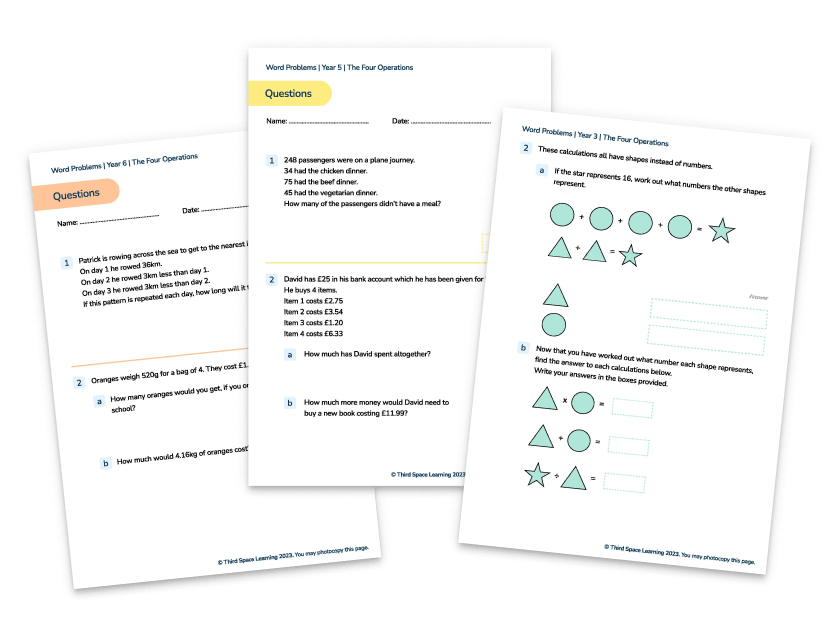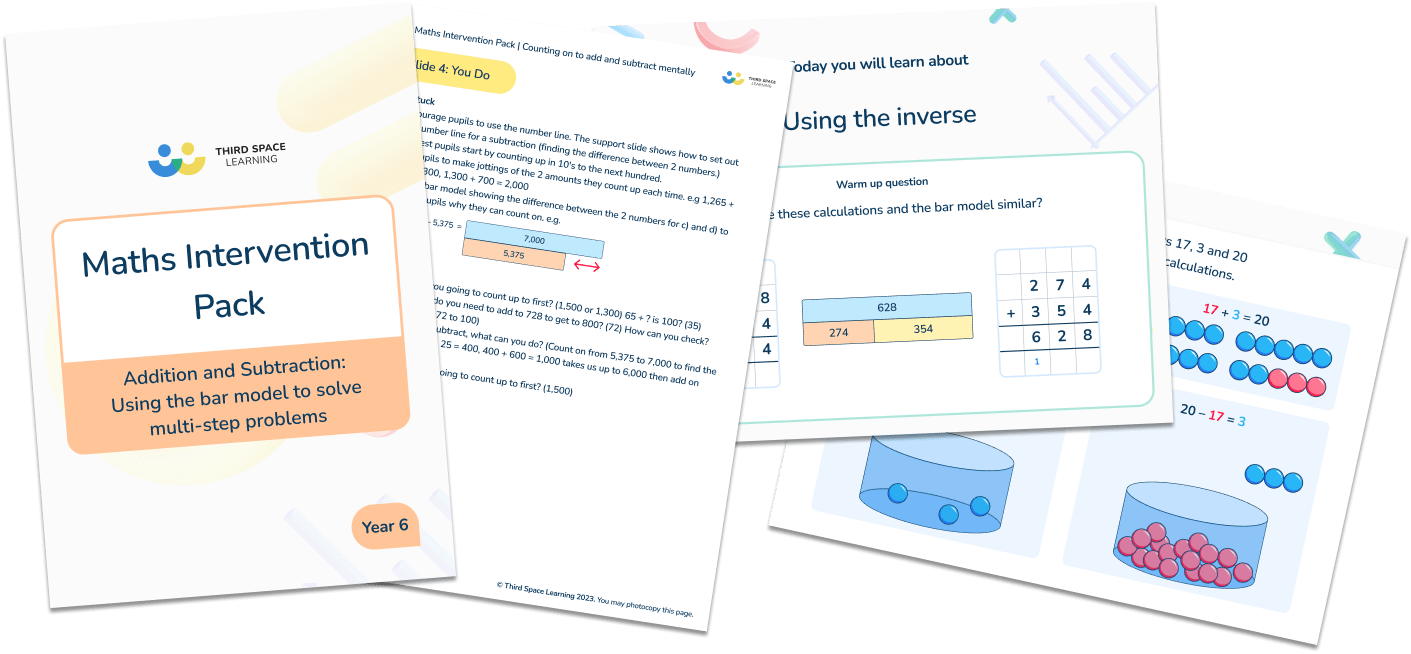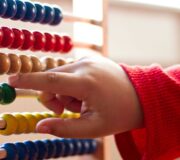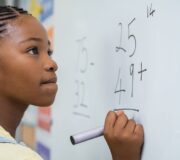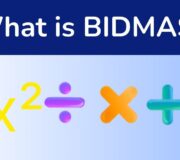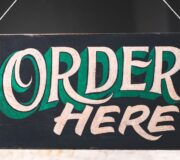Teaching Addition and Subtraction KS2: A Guide For Primary School Teachers From Year 3 To Year 6
Addition and subtraction in KS2 maths builds on the foundational skills pupils acquired in Key Stage 1, helping them perform more sophisticated mathematics, and solve more complex problems.
This post will show you what that progression looks like from Year 3 to Year 6, what your students/child should be able to do before moving on, and finally offer some practical suggestions as to how some objectives could be taught in the classroom.
What is addition and subtraction?
Addition and subtraction are two of the ‘Four Operations’ – the four core maths concepts children need to tackle the rest of the subject. Addition is the act of putting two or more numbers together to obtain a larger result, and subtraction is the reverse – removing one or more numbers from another to obtain a smaller result.
Addition and subtraction are among the first maths skills children are taught, and are key in developing their number sense.
Addition and subtraction KS1
In Early Years Foundation Stage (EYFS), young children in nursery and reception are developing number sense, including subitising. This is a core stepping stone to other areas of numeracy.
At Key Stage 1, pupils learn basic addition and subtraction. In line with the National Curriculum, they are expected to be able to fluently use addition facts and subtraction facts up to 20 (i.e. one and two-digit addition), and work with related facts up to 100.
Pupils will only encounter relatively basic number sentences, and most teaching will incorporate manipulatives and simple visual representations such as flashcards and number lines.
Teaching addition and subtraction KS2 – Before you begin…
It is an understatement to say that a secure understanding of how place value works in base 10 is a key component to success in addition and subtraction in maths.
Along with students developing their mental models of number and understanding the ‘numberness’ of numbers between 1-20 e.g. four can be made the following ways:
- 4+0
- 1+3
- 2+2
- 2+1+1
- 1+1+1+1
Number bonds within 20 are also a key element that should be near to a high degree of fluency – meaning that students should no longer have to attend to solving them – by this stage.
Students that have this conceptual understanding of number and the number system are far more likely to be successful when it comes to manipulating numbers in KS2 maths and beyond, especially when tasked with doing so mentally.
Therefore, before you begin teaching this unit, it is worth knowing that when we teach for mastery, out first step is to ensure the pre-requisite knowledge needed to be successful – it is not enough that just by the pupils being in your year groups that they grasped the fundamentals and are ready for what the National Curriculum deems to be ‘Year 3 content’.
It is recommended that regardless of the scheme of work your school follows, you look at the National Curriculum for ‘addition and subtraction’ and ‘place value’ for Year 2 and make sure that your pupils can meet those objectives first (e.g. pupils are familiar with solving problems with 2-digit numbers), as well as making sure that you’ve finished teaching place value Year 3, before you begin addition and subtraction in Year 3.
Still teaching place value, or looking to get pupils caught up? Third Space Learning have plenty of free place value worksheets to download and keep!
If you are comfortable that the students are secure, then carry on reading.

Unlimited primary maths tutoring with Skye, the voice-based AI maths tutor.
Built on the same principles, pedagogy and curriculum as our traditional tutoring, but with more flexibility, reach and lower cost.
Join the schools already helping hundreds of primary pupils nationwide with Skye’s one to one maths tutoring.
Watch Skye in actionTeaching addition and subtraction KS2: The theory
It’s important to remember that students should still be using manipulatives at this point to help them with their conceptual understanding of the mathematical knowledge they are gaining.
A possible error that new teachers may fall foul of is that because the objective in the National Curriculum mentions that calculations must be done ‘mentally’, they may take that to mean that manipulatives cannot be used.
Here it is worth reminding teachers that these objectives are the outcomes; it is totally appropriate (and I would argue necessary) to use manipulatives as part of a concrete, pictorial, abstract (CPA) approach when beginning to teach this unit.
Of course, the purpose of any manipulative is to show the underlying mathematical structure so that it is understood; then gradually reduce the need for its requirement. Maths manipulatives teachers may want to consider to help teach this unit include:
- Place value counters
- Dienes blocks
Visual representations a teacher should use, but eventually discourage use of include:
- Bar models
- Part-whole models
- Place value charts
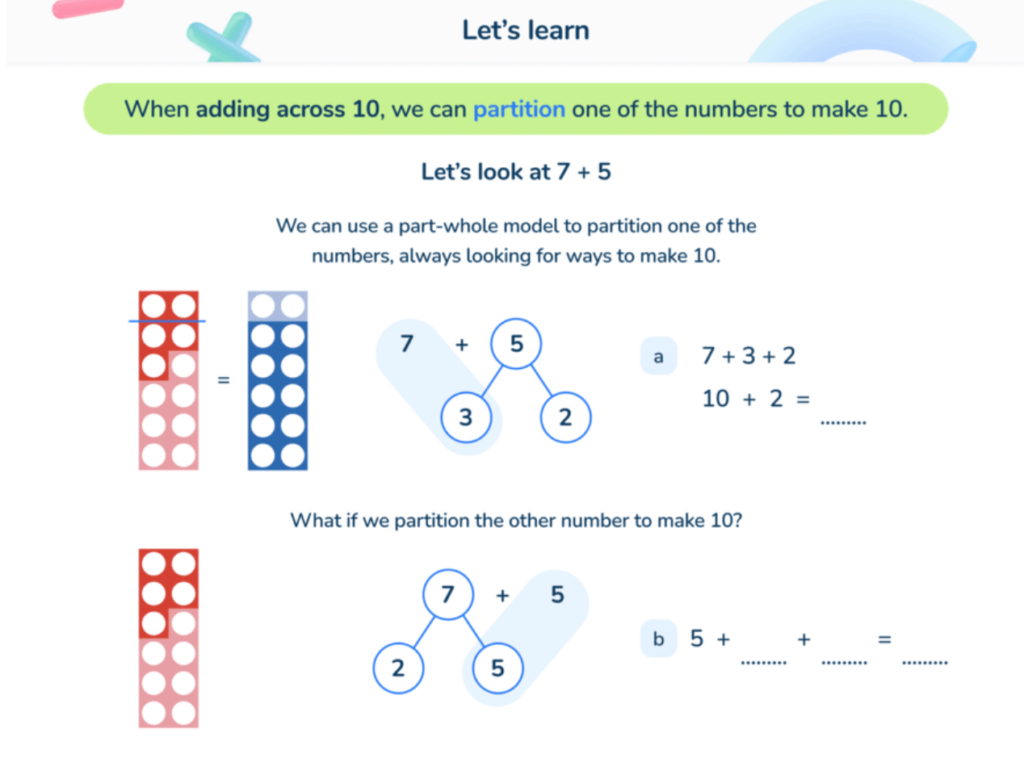
(Number lines are, by this point, too simple a representation to use with most pupils.)
If sourcing these manipulatives is hard, the Mathsbot website has some virtual ones that can be shown on a large interactive whiteboard.
Addition And Subtraction Gap Plugging Lessons Resource Pack
Plug gaps and help conquer common KS1 & KS2 misconceptions in addition and subtraction
Download Free Now!Addition and subtraction Year 3
In the National Curriculum for maths in England, for each area of maths outlined, there is both a statutory requirement and a non-statutory requirement. The statutory requirement is as follows:
- Add and subtract numbers mentally, including:
- a 3-digit number and ones
- a 3-digit number and tens
- a 3-digit number and hundreds
- Add and subtract numbers with up to three digits, using formal written methods of columnar addition and subtraction
- Estimate the answer to a calculation and use inverse operations to check answers
- Solve problems, including missing number problems, using number facts, place value, and more complex addition and subtraction.
The non-statutory notes and guidance suggests:
- Pupils practise solving varied addition and subtraction questions. For mental calculations with two-digit numbers, the answers could exceed 100.
- Pupils use their understanding of place value and partitioning, and practise using columnar addition and subtraction with increasingly large numbers up to three digits to become fluent
Addition and subtraction activities ideas Year 3
A good easy way into the objective ‘add and subtract numbers mentally…’ is to look at the addition and subtraction of multiples of one hundred. Dienes blocks are useful here as the pupils should be familiar with them from previous years.
Furthermore, you can demonstrate the relationship between ones, tens and hundreds by counting to 10 in ones, 100 in tens and 1,000 in hundreds. By asking students ‘what do you notice?’, they will soon see the relationship between the amount of physical pieces you have and the quantity they represent.
Once pupils have seen this pattern and are familiar, teachers can encourage whole class skip counting, both forwards and backwards, playing games like showing a set amount of the 100 block, getting the students to close their eyes and hiding a set amount.
The pupils will then have to tell you how many there were originally, how many were taken and how many are left. This can then be modelled to show a formal calculation.
This will help improve the students understanding of place value and mental calculations. Furthermore, it will allow the students to feel successful, which will inspire them to try some of the more difficult objectives.
The next step would be to take multiple of 100 away from numbers that have a value in the hundred, tens and ones.
Addition and subtraction word problems Year 3
A typical example of a word problem that students may be expected to solve by the of this period of teaching would look like this:
Mr. Almond has 429 marbles in a box. He adds 8 more bags of 10 marbles. How many marbles does he have now?
For this addition word problem the students would be expected to know that 8 bags of 10 marbles would be 80 and this needs to be added to 429. Note that students should use a formal written method (column addition) by the end of the unit, but it would be worth also discussing mental strategies for this problem, as it is quite probable that students will partition the ones from 429 to make 420, add 80 to this (using their knowledge of number bonds and place value) before finally bringing back the 9 to get 509.
Mr. Almond has 425 marbles in a box. He loses 39. How many are left over?
Similarly, the end goal of the unit would be for pupils to solve this subtraction word problem with column subtraction, but once again discussing possible mental subtraction strategies is highly recommended.
Addition and subtraction: reasoning and problem solving Year 3
There is, of course, more to the learning of maths than just learning these objectives, and reasoning and problem solving should not just be limited to word problems. These questions will help develop the reasoning and problem-solving questions from this unit.

Is this the most effective method? Discuss.
Once the formal column method has been learnt, there is a tendency to overuse it. By giving students questions like this, it reinforces that we are merely providing new mathematical tools for the learner to use as they wish when they deem it appropriate. We need to be reminding students that there is always more than one method they can draw on.
Creating problems that vary slightly to what a student has typically seen or experienced, is a good way to see if a student understands the underlying maths or is merely able to parrot a method back at you.

This bar model question may cause some issues at first as there are three numbers that have been added together to make the whole and the missing part comes between the two other parts and not at the end, as is typically seen in a classroom. This problem allows greater discussion of the underlying mathematics particularly the commutative property of addition which would allow the students to rearrange the bars as below.
Read more: What is a bar model

It is these types of questions that will push pupils’ addition and subtraction skills and set them on the path to being true mathematicians. These skills can then be used in other topics – for example, as a key part of teaching statistics and data handling.
Addition and subtraction Year 4
- Add and subtract numbers with up to 4 digits using the formal written methods of columnar addition and subtraction where appropriate
- Estimate and use inverse operations to check answers to a calculation
- Solve addition and subtraction two-step problems in contexts, deciding which operations and methods to use and why.
Non statutory notes and guidance:
- Pupils continue to practise both mental methods and columnar addition and subtraction with increasingly large numbers to aid fluency
Addition and subtraction lesson ideas Year 4
As well as revisiting the objectives from Year 3 (remember those pre-requisites), in year 4 students move on to working with numbers within ten thousand.
Because of the hierarchical nature of maths (there is a certain order that knowledge of the domain needs to be taught in for the rest of it to make sense and stick) it is so crucial that students are comfortable with counting in 100s.
Building on the advice given in Y3 but considering using place value counters could be one such way into this unit – though it is hoped that by this point, students are secure in their understanding of place value. For this section, I want to focus on the objective, ‘Estimate and use inverse operations to check answers to a calculation.’
Depending on the prior experiences of the students, using Cuisenaire rods can be helpful in showing this.

With plenty of practice of counting from the smaller number up to the larger number, coupled with the physical taking away using place value counters, students should quickly grasp this idea.
If students are already familiar with the idea they can move to the next part.
Column addition and column subtraction
In year 3, students encounter the formal written method of column addition and column subtraction. It is common practice for the method of column addition to be taught first, swiftly followed by column subtraction.
This is an area that is generally taught well by teachers, as they would likely have been taught this method themselves when at school.
Assuming automaticity within both methods, when students reach year 4 it is possible to combine both column addition and subtraction in order to ensure that students can use the inverse to check their answers.
As students are now becoming familiar and increasingly familiar with the column method for addition and subtraction, now is an excellent time to add in one more step to the method, which is to perform the inverse calculation as part of the process. This would be what the students are familiar with already:
4,532 +3,653 7,185
What I would propose is the following:
4,532 +3,653 7,185 3,653 - 4,532
Here the students have taken the sum and an addend from the addition part of the calculation and used them to form a minuend and a subtrahend of a subtraction calculation. The difference between the minuend and the subtrahend was also the first addend of the addition question. If this is the case, then the original question has been answered correctly.
Addition and subtraction word problems Year 4
A typical problem you would expect students to answer would be the following:
Mr. Almond buys a laptop for £2,482 and a tablet for £1,239. How much did he spend altogether?
Students should use a bar model to represent this addition word problem.
And then use a formal written method to solve – including the use of the inverse calculation at the end.
2,482
+1,239
3,721
1,239 -
2,482
Addition and subtraction: Reasoning and problem-solving Year 4
When looking at creating reasoning and problem-solving activities, it is highly appropriate to look back on the objectives from previous years and create a reasoning or problem-solving activity based on them.
In mathematics, maturation matters. If some ideas are still too novel for students, despite them showing some success with them, then solving problems with them can overwhelm them.
As we want students to attend to the mathematics, creating difficult problems but with numbers they are more comfortable with frees up the students thinking to consider the structures and not worry about the numbers. A good problem to look at would be missing numbers in a calculation.
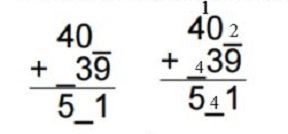
Plenty of reasoning is available in these questions. Students can look at the addend and sum and reason the missing number must be an even number as adding an even number to an odd number produces another odd number.
These questions also allow students to practice their fluency of number bonds. These questions can vary in difficulty by bridging to the next place value or not – something that students often find difficult during these tasks.
Addition and subtraction Year 5
- Add and subtract whole numbers with more than 4 digits, including using formal written methods (columnar addition and subtraction)
- Add and subtract numbers mentally with increasingly large numbers
- Use rounding to check answers to calculations and determine, in the context of a problem, levels of accuracy
- Solve addition and subtraction multi-step problems in contexts, deciding which operations and methods to use and why
Non statutory notes and guidance:
- Pupils practise using the formal written methods of columnar addition and subtraction with increasingly large numbers to aid fluency.
- They practise mental calculations with increasingly large numbers to aid fluency (for example, 12,462 – 2,300 = 10,162)
Addition and subtraction activities Year 5
As students continue to develop their maths skills in this area, it is hoped that they are now fluent in using the column method and have developed a strong understanding of the place value system. In year 5 place value, students learn numbers to at least 1,000,000. It is therefore likely that the questions you use will include 4-digit numbers, and possibly up to 6-digit numbers.
To add an element of challenge into the teaching at this step, teachers could try some of the following:
- Provide equations that require balancing on both the left and the right-hand side of the equal sign. E.g. 142,530 + 432,943 = 354,954 + ________
- Ask students to first of all round the numbers in the question to a nearest whole place value to estimate the answer first.
E.g. 142,530 + 432,943 = 354,954 + 220,519
142,500 + 432,900 = 355,950 + 219,450
Doing this further enhances students understanding of the equals sign while practising rounding skills. You could challenge students to round the same numbers to the nearest hundred thousand, ten thousand, thousand, hundred and tens to investigate which rounding will give an estimate nearer the final answer.
Addition and subtraction word problems Year 5
At this stage, in accordance to the National Curriculum, students should be solving multi-step problems in context. A typical problem could be something similar to the following:
Journey Distance (kilometres)
London to Paris 934 km
London to Rome 1461 km
Paris to Rome 1186 km
A plane flies from London to Rome and then on to Paris.
How much further is this than flying direct to Paris from London?
1461 km + 1186 km = 2647 km
2647 km – 934 km = 1730 km
This question relies on students having an understanding of measurement and uses numbers that they are familiar with. Again, with two-step problems, using slightly easier numbers is actually beneficial as it allows students to concentrate on understanding the language and structure of the question as to why it is a multiple step problem. Students should encounter plenty of worked examples of these before attempting their own.
Addition and subtraction: Reasoning and problem-solving Year 5
Reasoning and problem-solving in year 5 gets more sophisticated. Numbers are exchanged for symbols and a greater use of unknown quantities is used to get students to reason about their knowledge of number, laying the foundations for Algebra in year 6. A typical problem may take the form of the following:
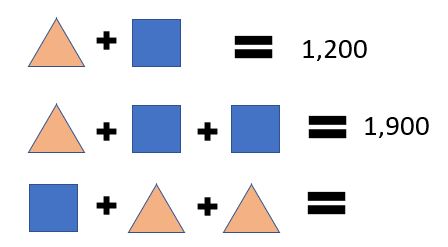
The way to tackle a problem such as this is to ask students what is the same and what is different about the first two calculations. Teasing out that the difference between the two equations is one square and that the difference between the two answers is 700. From this, students can deduce that a square is equal to 700 and therefore a triangle is 500.
When adding two triangles and a square together, you get the answer 1,700.
Read more: Teaching Addition In Year 5 And Year 6: How To Identify and Fix The Most Common Gaps
Addition and subtraction Year 6
- Perform mental calculations, including with mixed operations and large numbers
- Use their knowledge of the order of operations to carry out calculations involving the 4 operations
- Solve addition and subtraction multi-step problems in contexts, deciding which operations and methods to use and why
- Solve problems involving addition, subtraction, multiplication and division
- Use estimation to check answers to calculations and determine, in the context of a problem, an appropriate degree of accuracy
Non statutory notes and guidance:
- Pupils practise addition, subtraction, multiplication and division for larger numbers, using the formal written methods of columnar addition and subtraction, short and long multiplication, and short and long division.
- They undertake mental calculations with increasingly large numbers and more complex calculations.
- Pupils round answers to a specified degree of accuracy, for example, to the nearest 10, 20, 50, etc, but not to a specified number of significant figures.
NOTE
In the maths National Curriculum for year 6, addition and subtraction is coupled with multiplication and division. Present are the only objectives and guidance relevant to addition and subtraction.
The objective, ‘ Use their knowledge of the order of operations to carry out calculations involving the 4 operations’ will be discussed in the multiplication and division part of this series.
Addition and subtraction word problems Year 6:
When looking at year 6 word problems, pupils should be able to solve them in a range of real-world contexts (money and measurement for example) as well as with up to 2 decimal places. A common subtraction problem for this age group could be something on the lines of the following:
The Children and Green Forest School are raising money for a charity. Their target is to collect £380. So far they have collected £77.73. How much more money do they need to reach their target?
The difficulty in this subtraction word problem is the requirement that when performing the subtraction, students must remember to include two-zero place holders from the target number to ensure the place value is correct.
380.00
77.73 –
Students will then have to cross three place value holders to the tens column in order to perform all the necessary exchanging which adds an additional level of difficulty. Once the calculation has been performed, students should get the answer £302.27.
Home learning is also likely to increase in Year 6 as parents help their pupils prepare for the SATs, so it’s worth ensuring any resource packs, maths games, addition and subtraction worksheets etc. you may send home also follow these aims.
Addition and subtraction: Reasoning and problem-solving Year 6
The following question from a past Key Stage 2 SATs paper provides an insight into the type of reasoning and problem solving that is expected by the end of Year 6.
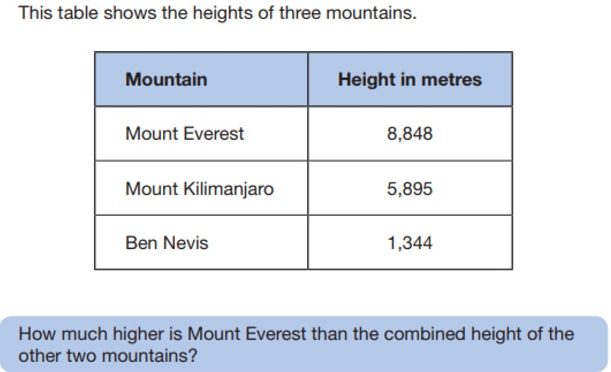
Pupils are expected to take the information from the table and perform 2-steps calculation – find the combined height of Kilimanjaro and Ben Nevis and then the differences between this total height of both mountains and Everest. This could be represented in the following way using bar modelling to making the two calculations clearer to see.
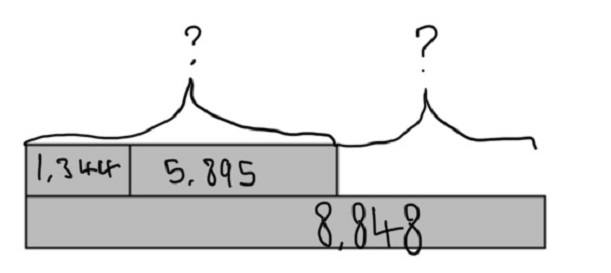
Adding both heights of Kilimanjaro and Everest gives a height of 7,239 metres. When this is subtracted from the height of Everest (8,848m), you are left with the answer 1,609 metres.
Read more: Teaching Subtraction In Year 5 And Year 6: How To Identify and Fix The Most Common Gaps
Addition and subtraction are the first mathematical skills that pupils really get to grips with, and having a strong foundation in them is key to becoming better mathematicians. Hopefully this post has given you some good ideas to achieve exactly that for your class, no matter which KS2 year they are in!
DO YOU HAVE STUDENTS WHO NEED MORE SUPPORT IN MATHS?
Skye – our AI maths tutor built by teachers – gives students personalised one-to-one lessons that address learning gaps and build confidence.
Since 2013 we’ve taught over 2 million hours of maths lessons to more than 170,000 students to help them become fluent, able mathematicians.
Explore our AI maths tutoring or find out about online maths tuition for your school.
